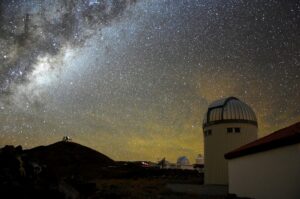Astronomers from the UW Astronomical Observatory have discovered a massive variable star, or classical Cepheid, with the longest pulsation period in our Galaxy. According to the researchers, it is not only the brightest, but also probably the youngest known classical cepheid in the Milky Way – it is 22 million years old.
The new star, which has a relatively long pulsation period, was discovered using the Warsaw Telescope at the Las Campanas Observatory in Chile as part of the Optical Gravitational Lensing Experiment (OGLE), a long-term sky survey involving regular photometric observations of about two billion stars in our galaxy and in the Magellanic Clouds.
According to the study, classical Cepheid in the Galaxy, named OGLE-GD-CEP-1884, can be categorised as the first ultra-long-period Cepheid in the Milky Way. The period of 78.14 days is nearly ten days longer than that of the previous record-holding Cepheid, S Vulpeculae.
OGLE-GD-CEP-1884 has a magnitude in the V-band of 16.83, an average radial velocity of -72.3 km/s, and its age is estimated at 22 million years. Astronomers have noted that such parameters make this star probably the brightest and youngest Galactic Cepheid. The distance to this star is about 14,500 light-years.
Astronomers noted that it was strange that OGLE-GD-CEP-1884 had not previously been identified as a long-period classical Cepheid, given its brightness, especially in long waves. Therefore, they suggest that there may be more such Cepheids in the Milky Way that remain undetected.
The OGLE research team, led by Prof. Andrzej Udalski, has been investigating the pulsating supergiant Cepheids for years. Thus, nearly half of the discovered classical Cepheids of the Milky Way has been discovered by the astronomers from the Astronomical Observatory of the University of Warsaw. In 2019, the researchers led by Prof. Dorota Skowron presented a unique three-dimensional map of the Milky Way, which provides insights into the structure and history of our Galaxy. The map demonstrates that the Milky Way disk is not flat, it is warped at distances greater than 25,000 light years from the Galactic centre.
The discovery of the classical cepheid with the longest pulsation period was published in The Astrophysical Journal Letters (https://doi.org/10.3847/2041-8213/ad392f).

ph: The Milky Way above the Las Campanas Observatory located in the southern Atacama Desert in Chile/ Science in Poland in 34 Snapshots. https://nawa.gov.pl/images/zdjecia/ResearchinPoland/Science_in_Poland_v1.25a-www.pdf
Source:
https://en.uw.edu.pl/the-ultra-long-period-cepheid/
https://ogle.astrouw.edu.pl/cont/4_main/var/ogleiv/cep_long_per/
https://universemagazine.com/en/astronomers-discover-cepheid-with-the-longest-pulsation-period/


